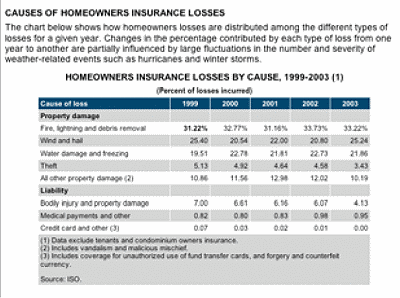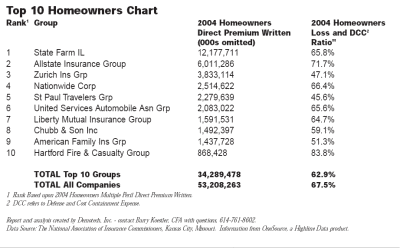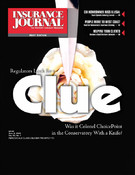Was it Colonel ChoicePoint in the Conservatory With a Knife?
When ChoicePoint Asset Co. finally disclosed Feb. 15 that criminals had gained access to the personal information of as many as 145,000 people in all 50 states, it came as a wakeup call to many that the information lenders, creditors and, yes, insurers use in their financial decisionmaking was frighteningly vulnerable to socially engineered fraud.
Company executives have faced intense scrutiny in Congress, in state capitals, and in the news media for not stopping the fraud and not disclosing it sooner. While it was the insecurity of the Alpharetta, Ga.-based firm’s credit scores that put ChoicePoint on front pages across the nation, it’s the mere availability of certain types of homeowners insurance claims data that has left regulators, consumer advocates and independent agents looking for a clue.
ChoicePoint’s Claims Loss Underwriting Exchange database, known as CLUE, collects loss-history information for both auto and homeowners insurance, but it’s the latter that has put the claims-reporting practices of CLUE and its insurance carrier contributors under the magnifying glass.

In the last year and a half, 17 states have taken action legislatively or regulatorily and more than 30 states had proposals in the works in 2004 to change what counts as a claim reportable to the CLUE database.
Inquiring minds want to know
What is a claim? At first blush, it might seem like a simple question. But with the onset of the first homeowners insurance hard market in decades, carriers scrambled to shed risks with any kind of losses–or in some cases, the mere hint of losses–and began concluding, contra Freud, that sometimes a coverage inquiry is not just a coverage inquiry.
Anecdotal evidence suggests that there have been cases where a consumer has called her agent or the company to inquire about how and whether her policy would cover, for example, water damage in the event of a pipe bursting.

“What’s my deductible?” she asked her agent.
“That’s a claim,” some insurers decided.
Steve Gillard, ChoicePoint’s assistant vice president in data services responsible for CLUE, told Insurance Journal that insurers that contribute loss-history information to the database can no longer count coverage and deductible inquiries as claims. Still, there appears to be wiggle room for insurers with a mind to be picky.
“We don’t have this perfect definition of what’s an inquiry and what’s a claim,” said Lynn Knauf, personal lines director for the Des Plaines, Ill.-based Property Casualty Insurers Association of America.
“It’s a very imperfect science. A customer can call and report that something happened, and from there on a million different scenarios could happen. By the time something gets to a loss-history report it’s because there is a claim number associated with it.
“Do companies consider things claims that consumers don’t consider claims?” Knauf asked. “Sure, but there again that’s a double-edged sword. A customer could be calling about liability or coverage because they understand a loss has occurred and it becomes predictive of future risk.”
In spite of that argument, both ChoicePoint and the carriers seem to realize they’ve lost this particular battle in the war over CLUE.
“It’s ridiculous that insurers have been using inquiries,” said Birny Birnbaum, executive director of the Austin, Texas-based Center for Economic Justice and a former regulator with the Texas Department of Insurance. “Anyplace they’re challenged on inquiries, they agree to give it up. Why are they using it in the first place?”
No claim, no payment?
Bureaucrats and politicians have also targeted several other homeowners insurance underwriting practices, such as counting as a loss a claim closed without payment. According to ChoicePoint’s Gillard, member companies are allowed to report claims closed without payment under certain conditions.
“We’ve held on to the idea,” he said, “that if they have a loss and they’ve established a reserve, incurred loss adjustment expenses, or formally denied a claim because either the claim was under the deductible or the proximate cause of loss was not a covered peril or because the consumer withdrew the claim–all of those should be reported. … We report those losses as zero paid.”
According to Knauf, insurers have good reasons to count these occurrences as claims even though no money was paid out to the insured. She offered the example of a water loss that was not covered by the policy or was under the deductible.
Though no payment was made, she said, “That may lead to future concerns about damage to property, or mold or future sump-pump backup claims. There may be concerns about future insurability of the risk. It doesn’t mean companies are jumping to get off the risk. It may be relevant for insurers to know.”
She added that many times claims are withdrawn when the adjuster suspects fraud and requires an examination under oath.
“That’s a huge problem, a huge red flag,” she said, and something that will go unaccounted for if insurers are prohibited from reporting no-payout claims.
Claims baggage
To many, the arguments for CLUE’s status quo ring hollow.
“We think that the use of inquiries and claims made but not paid is fundamentally unfair to consumers,” North Dakota Commissioner Jim Poolman told IJ.
“We’ve gone along and approved the companies that wanted to raise the deductibles and have percentage deductibles. We’ve done a lot of the things they asked for to keep homeowners insurance available in this state.
“But now,” Poolman added, “that same customer is afraid of calling their company or calling their agent for fear that that may count against them. And then what happens if they have a $1,000 deductible on the roof, but they have no idea if the damages will add up to that much. Then it turns out be $1,400 in damages on a $1,000 deductible, so people pay for it themselves and it still counts against them.
“We think their reasoning is not appropriate,” said Poolman, a vocal leader and former vice president of the National Association of Insurance Commissioners. “Insurance companies want to have it both ways. They don’t want to have [customers] file small claims but when they do the right thing [insurers] still use it against them.”
A common complaint is that loss-history databases like CLUE remove the human touch from the underwriting process.
“Oftentimes, CLUE is being used as a crutch, almost an exclusive factor in the underwriting process rather than an element,” according to Wes Bissett, senior vice president of state relations for the Independent Insurance Agents and Brokers of America. He addressed the subject as a panelist at last summer’s National Conference of Insurance Legislators’ meeting in Chicago.
“Consumers don’t know how they’ll be impacted, but they know that they will. It’s not rational to force consumers into the position of choosing between making a claim and paying higher premiums in the future.”
CEJ’s Birnbaum said “insurers are enamored of their risk-classification and technology tools. It’s easier for them to just use their statistical tools and control it from the main office, where they don’t have to rely on agents or hire inspectors. It’s a very short-term approach. One of the problems with insurance today is it’s fixated on short-term, bottom line, do things that make no sense in the long-term.”
Clashing claims
Regulators and legislators have tried to force insurers to consider remediation or mitigation of a risk (e.g., a tree from the yard fell on the roof of the house and now all of the trees have been removed from the yard), prohibit consideration of claims made by a previous owner of the property, prohibit declinations or nonrenewals for a single loss, and prohibit insurers from counting certain weather-related claims.
California Insurance Commissioner John Garamendi was perhaps the earliest and most aggressive on the matter, issuing an emergency regulation in 2003 that prohibited insurers from relying solely on loss-history databases. Almost immediately, Safeco Insurance stopped writing new business in the state. The regulation was struck down by a California court in August 2003 but Garamendi may still appeal.
In North Dakota, Poolman is pushing a bill that would prohibit insurers from counting an insured’s first weather-related claim against him unless they can prove he failed to properly maintain the property.
“If there’s one wind and hail claim, you shouldn’t use that against them,” Poolman argued. “Who knows when it’s going to hail again here? Just because they had one catastrophic loss doesn’t mean you should be able to go in and deny or nonrenew a customer. Some companies want to use claims going back 20 years. That’s absolutely unreasonable. It doesn’t make any sense.”
Considering that 25 percent of homeowners insurance claims are due to lightning or hail, according to a 2003 Insurance Research Council report, this proposal is nothing to sneeze at. Lobbyists for insurers argue that underwriting restrictions will ultimately hurt consumers.
“If you start layering on restrictions on how companies can and cannot underwrite the business,” PCI’s Knauf said, “if you start requiring them to inspect the property before insuring it … that cost ultimately has to be passed onto the policyholder. That’s a huge chunk compared to the annual premium. And if they can’t consider losses that have been mitigated then that’s a problem because even if an insurer has paid the claim and mitigated the problem, it stills pose a loss frequency problem.”
America’s next top model
A so-called “consensus model” bill that has the support of the major insurance trade groups appears close to passing NCOIL. It would bar insurers from reporting inquiries as claims, prohibit sole reliance on CLUE reports to deny, cancel or nonrenew, mandate disclosure to insureds, and allow claims closed without payment to be reported as losses if the carrier can prove to its state commissioner that “such events relate to the risk of the insurer.”
The model bill was supposed to come up for a vote at the group’s spring session but was tabled at the last moment. It will be taken up again in July, according to Texas Rep. Craig Eiland, also NCOIL’s president.
“I think we’re getting closer to having something that we can run with,” he told IJ. “It’s my intent to vote on the NCOIL model in July and no later.”
The NAIC, meanwhile, has only recently assigned the matter to a committee and begun working on a draft of its own model legislation, which would likely be much more restrictive considering the support the initiative has from Poolman as well as Oregon Insurance Administrator Joel Ario.
“The insurers’ strategy is go to NCOIL and get a model that doesn’t include consumer protections,” charged Birnbaum, who is an NAIC-funded consumer representative. “Then they’ll go to the NAIC, stall and try to prevent them from doing anything.”
Market timing
As so often happens, the legislative/regulatory response has lagged behind the reality of the marketplace. Only half a dozen states have proposed CLUE-related activity this year. Part of that is because the politicians want to see what emerges from the NAIC/NCOIL soup before acting, but it’s also due to the turn in the cycle.
According to the Insurance Information Institute, homeowners insurance expenses will rise by a mere 2.5 percent in 2005 (compared to a 10.6 percent rise in 2002), meaning actual rates will be close to flat.
“Outside the Southeast, homeowners insurance is finally profitable,” said Robert Hartwig, the group’s chief economist. “Going from a 122 percent combined ratio in 2001 down to 95 percent, excluding the Southeast, is very good. Even backing that out to the national number, it’s still closer to about 98 or 99 percent.”
This compares to a 150 percent industry composite combined ratios that were typical for many years.
While Hartwig and others said changes in underwriting conditions, such as increased deductibles and mold exclusions, demonstrated some discipline among insurers, it’s clear that they are beginning to show an appetite for risks with some losses–risks they wouldn’t have touched with a Yao Ming-sized pole three years ago.
Janet Phillips, vice president of personal lines for Indianapolis-based wholesaler Arlington/Roe & Co., told of a risk she lost to a standard-market independent agency carrier. The risk had a $5,600 windstorm loss, a $1,000 water loss, and a $2,700 lightning loss in the last three years, but a $2,500 deductible was enough to convince the insurer to take it on.
Fear eats the losses
In spite of the great results in 2003-04, it’s no soft market yet, according to Brian Sullivan, editor of Property Insurance Report. “As I talk to carriers,” he said, “still no one is saying, ‘Boy, I can’t wait to get more homeowners.’ They’re still very wary of the business. There are still concerns about making money over time, and they are not going to come storming back with a lot of aggression.”
In addition to upping deductibles to dissuade insureds from using their homeowners insurance as maintenance policies, carriers have also benefited from sinking claims costs, Sullivan said, “because consumers are scared that they’re going to be canceled.”
They’ve heard the horror stories about homeowners making claims, or even inquiring about their coverage, only to be punished with sky-high rates and cancellation notices.
“You have relatively unnatural suppression of claims because of consumer fear of insurer response,” he said, warning the situation is temporary.
And to what do insurers owe this profit-boosting fear of claims? Surely, they would tell you: They haven’t got a clue.
Topics Texas Carriers Agencies Profit Loss Legislation Claims Underwriting Property Homeowners
Was this article valuable?
Here are more articles you may enjoy.


 Catastrophe Bond Investors Told to Brace for Jamaica Payout
Catastrophe Bond Investors Told to Brace for Jamaica Payout  Suspects in Louvre Heist in Custody After Week-Long Manhunt
Suspects in Louvre Heist in Custody After Week-Long Manhunt  Security First the Latest in Florida to Announce Home Insurance Rate Cut
Security First the Latest in Florida to Announce Home Insurance Rate Cut  CyberCube: Insured Loss Estimate From AWS Outage Likely About $40M
CyberCube: Insured Loss Estimate From AWS Outage Likely About $40M 


